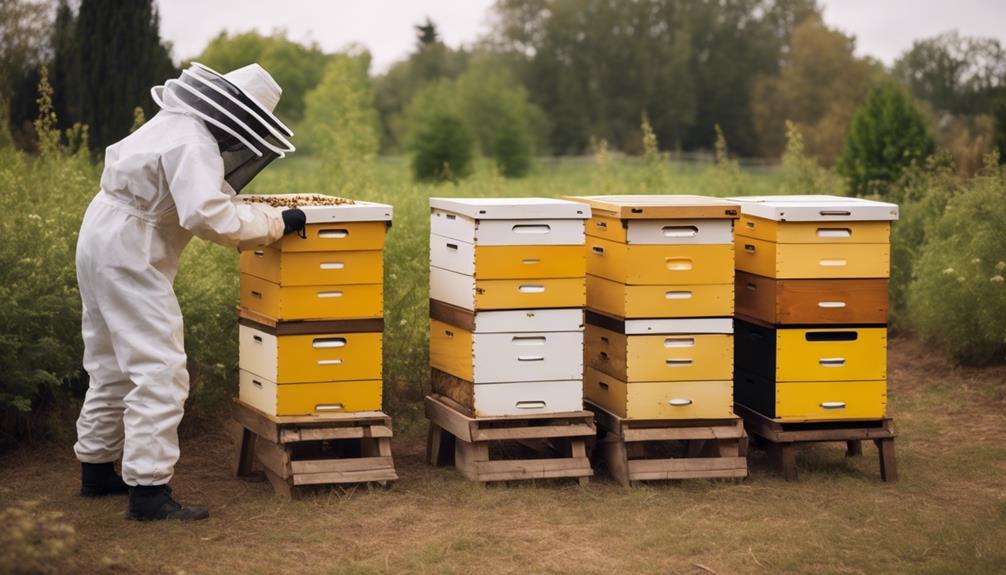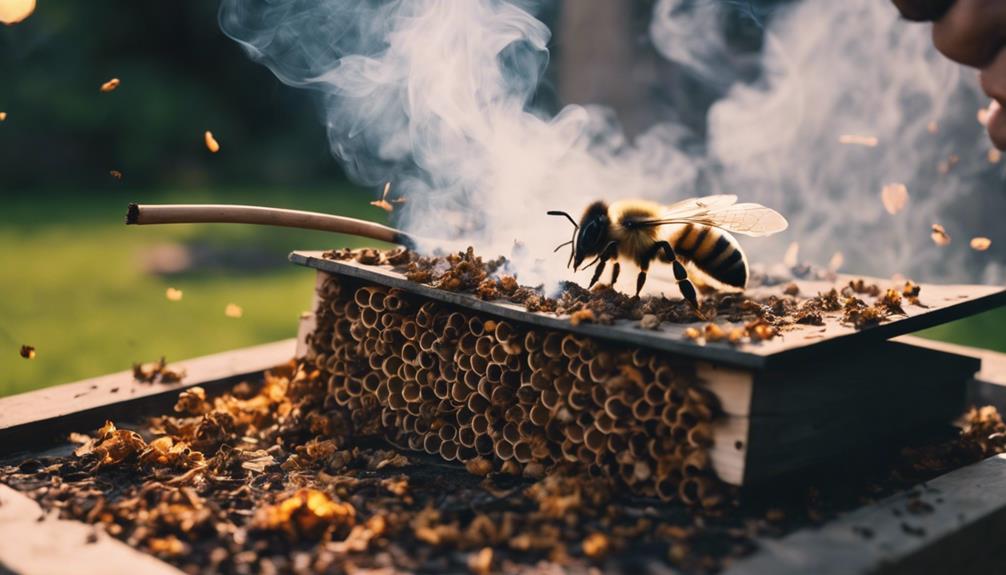When starting beekeeping, we recommend beginning with a single deep hive box. These boxes are perfect for both brood rearing and honey storage, simplifying tasks for new beekeepers. They offer flexibility for your colony to grow and survive winter. Starting this way paves the path for beekeeping success and gradual hive expansion. And if you’re curious about how to maximize hive efficiency and more, there’s plenty more to learn about hive sizes and setups.
Main Points
- Begin with a single deep hive box for brood rearing and honey storage.
- Opt for 8 or 10 frame equipment for simplicity and practicality.
- Set up two deep boxes for brood nest to support colony growth.
- Consider using medium boxes for honey supers for efficient management.
- Choose an all-medium hive configuration for streamlined handling and versatility.
Hive Size Considerations
When beginning beekeeping, it’s recommended to start with a single deep hive box to provide ample space for the initial honeybee colony. Deep boxes, also known as brood chambers or hive bodies, offer the perfect starting point for your beekeeping journey.
These deep hive boxes are ideal for efficient brood rearing and honey storage capacity. By starting with a single deep hive box setup, you simplify management tasks, making it easier for beginner beekeepers to learn the ropes.
Additionally, deep hive boxes provide versatility for colony expansion and winter survival preparations. This solid foundation sets you up for beekeeping success and gradual hive growth.
8 Vs. 10 Frame Equipment
Comparing 10 frame equipment with alternative options reveals its traditional appeal and practicality for novice beekeepers entering the world of Langstroth hives. The standard box dimensions and frame compatibility offer a straightforward starting point for those new to beekeeping.
With 10 frame equipment, setting up brood boxes and honey supers aligns seamlessly with common practices, making expansion and maintenance easier. This choice provides a foundation for learning about hive management and bee behavior without added complexities.
The familiarity of 10 frame equipment within the beekeeping community guarantees that resources, advice, and support are readily available. Starting with this setup establishes a solid groundwork for future hive management decisions and allows for a smooth progression in beekeeping knowledge and skills.
Brood Nest Setup

Setting up the brood nest in a beehive typically involves positioning two deep boxes to cater to the queen’s egg-laying needs and the development of young bees. These deep boxes provide ample space for the queen to lay eggs and for the brood to thrive. By utilizing two deep boxes, beekeepers make sure that the colony has enough room to expand and maintain a healthy population.
In colder regions, having two deep brood boxes becomes essential as it allows bees to store sufficient honey for winter survival. Monitoring honey stores, brood development, and overall hive health is vital for sustaining the colony. Proper management of the brood nest setup is key to supporting colony growth, health, and wintering success.
Medium Boxes for Supers
Utilizing medium boxes for honey supers in beekeeping operations offers a practical solution for efficient honey extraction and management. These medium boxes are a beekeeper’s best friend for handling honey with ease.
They might hold fewer frames than deep boxes, but they’re perfect for storing that extra sweet surplus. Many beekeepers swear by the versatility and convenience of medium boxes, especially in handling honey extraction.
The beauty of using medium boxes for supers lies in striking the right balance between storage capacity and weight. With these boxes, you can navigate your hive smoothly, ensuring a productive honey flow without the heaviness of deep boxes.
All-Medium Hive Configuration

When considering an all-medium hive configuration, we’re looking at a setup that streamlines equipment choices by using one box size for both brood and honey supers. This approach not only simplifies management but also lightens the load, with each full medium box weighing around 60 lbs at most.
While switching from different box sizes may pose some challenges, the allure of queen comfort and easier hive manipulation make the all-medium setup a popular choice among beekeepers.
Benefits of All-Medium
In our beekeeping journey, embracing the All-Medium hive configuration brings forth numerous advantages that simplify equipment management and optimize hive functionality. With bees storing honey in medium boxes, the All-Medium setup offers flexibility for hive management. Honey supers fit perfectly in medium boxes, making it easier for beekeepers to handle and extract honey.
The weight of each full All-Medium box is around 60 lbs at most, which is lighter compared to deep boxes, making maintenance simpler. This setup allows the queen to lay eggs comfortably, promoting a healthier hive environment.
Moving to an All-Medium setup may pose challenges initially due to differences in hive management, but the benefits of streamlined equipment and improved functionality make it a worthwhile choice for beekeepers seeking efficiency and ease.
Considerations for Beginners
Considering the benefits an all-medium hive configuration offers, newcomers can benefit from the simplicity and ease of managing a hive with uniform equipment. Here are some key points to keep in mind when selecting an all-medium setup for your first hive:
- Essential Handling: Medium boxes, weighing around 60 lbs when full, are manageable for beginners.
- Adaptability: Deep boxes are typically for brood, while medium boxes are perfect for storing honey.
- Switching: Moving to all-medium boxes later can be tricky due to traditional hive setups.
- Simplicity: Grasping the flexibility and simplicity of all-medium setups helps beginners in hive management.
Selecting the appropriate hive size and configuration is vital for a successful beekeeping journey. Starting with an all-medium hive can provide a balanced approach for newcomers seeking freedom in managing their hives.
Advantages of Cypress Medium Boxes
Embracing the efficiency of Cypress medium boxes enhances the beekeeping experience due to their user-friendly design and versatile functionality. These medium boxes offer advantages like simplicity and compatibility with foundation and frames, making hive management a breeze.
The lightweight nature of Cypress boxes, typically around 60 lbs when filled with honey, adds to their appeal. When used as honey supers during nectar flow, Cypress medium boxes provide flexibility for the queen and support the honey bee colony’s needs.
Additionally, opting for an all-medium setup streamlines equipment purchasing since only one type of box is necessary. With Cypress medium boxes, beekeepers can enjoy the freedom of a straightforward yet effective hive management system.
Impact on Beekeeping Operations

In beekeeping operations, the size of your hive plays a vital role. It impacts how we handle tasks like inspections, feeding, and maintenance.
The appropriate hive size can make our beekeeping activities more manageable and enjoyable.
Hive Size Considerations
Starting with the appropriate hive size is essential for successful beekeeping operations. When considering hive size, several factors come into play:
- Brood and Honey Storage: A single deep hive offers sufficient space for both brood rearing and honey storage, important for colony health.
- Bee Management: Hive size impacts how efficiently you can manage your bees, affecting tasks like inspections and pest control.
- Resource Management: Choosing the right hive size is crucial for optimizing resources like pollen and nectar collection for honey production.
- Colony Health: Properly managing hive weight and space allocation based on hive size is key to maintaining a healthy and thriving bee colony.
Operational Efficiency Implications
Enhancing operational efficiency in beekeeping operations involves optimizing hive size to strike a balance between colony needs and ease of management. Starting with a medium-sized hive offers this equilibrium, providing adequate space for brood rearing and honey storage while ensuring manageable hive management.
Medium hives aren’t only easier to handle than larger ones but also versatile, catering to colony requirements while reducing physical strain on beekeepers. The choice of a medium-sized hive promotes efficient resource utilization by the bees and simplifies equipment handling for beekeepers.
This size allows for gradual adjustments based on colony strength and seasonal demands, enhancing operational flexibility. By considering the operational efficiency implications, beekeepers can streamline their practices and create a harmonious environment for both bees and themselves.
Challenges of Different Hive Sizes
Handling the challenges posed by different hive sizes is a key aspect of beekeeping management. Here are some aspects beekeepers consider when dealing with various hive sizes:
- Larger hives like double deep configurations can be heavy when full of honey, making them harder to lift and maneuver.
- Smaller hive sizes, such as medium or shallow boxes, are lighter and easier to handle but may require more frequent checks and maintenance.
- Shifting from a mix of hive sizes to a uniform size can be challenging for beekeepers used to specific setups.
- Traditional frames in deep boxes are typically used for brood, while medium or shallow boxes are often designated for honey supers, where beekeepers harvest and extract honey.
Making an Informed Decision

When making an informed decision about beekeeping, it’s crucial to carefully evaluate the advantages and factors of starting with a deep hive box.
Starting with a deep box provides ample space for brood rearing and honey storage, making it easier to manage for beginners. The deep hive box offers stability, insulation, and versatility, creating a solid foundation for your colony’s growth.
To keep the honey safe, the deep box is the ideal location in the hive. When starting with a deep box, make sure to take into account the benefits it brings in terms of colony development and management.

Hello! My name is Noel Calvin. I graduated from UCLA and now work as a writer at Launch Ninjas. I write blog posts that inspire and guide our readers in their entrepreneurial pursuits. I live in Pleasantville, NJ, with a peaceful yet lively atmosphere that inspires me.
Writing stories is more than just a job for me. It allows me to share my observations and satisfy my curiosity about the world. I combine my analytical skills with creative enthusiasm to delve into technology trends and startup stories. But my life isn’t limited to screens and keyboards. I value loyalty, passion, and a touch of old-fashioned charm, which I infuse into every narrative I create.
I love spending time in my garage, jamming with my band when I’m not writing. Playing the guitar and singing bring me immense joy. I also enjoy capturing ordinary and extraordinary moments through my camera lens and exploring new culinary adventures that excite my taste buds. I’m always seeking new experiences.
My family is very important to me. Joyful Sunday brunches filled with laughter and intense board game nights keep me grounded, reminding me of life’s simple pleasures.
In my world, every moment is an opportunity for discovery. Every discovery is a story worth sharing, whether a heartfelt moment at home or the pulse of technological innovations. Join me as I navigate through life, one blog post, one guitar strum, and one heartwarming family dinner at a time.


